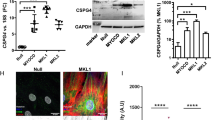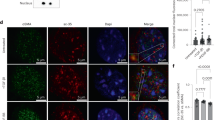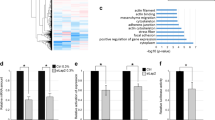Abstract
Two shortcomings of nonviral gene therapy are a lack of tissue-specific targeting of vectors and low levels of gene transfer. Our laboratory has begun to address these limitations by designing plasmids that enter the nucleus of specific cell types in the absence of cell division, thereby enhancing expression in a controlled manner. We have shown that a 176 bp portion of the smooth muscle γ-actin (SMGA) promoter can mediate plasmid nuclear import specifically in smooth muscle cells (SMCs). Here, we demonstrate that the binding sites for serum response factor (SRF) and NKX3-1/3-2 within this DNA nuclear targeting sequence (DTS) are required for plasmid nuclear import. Knockdown of these factors with siRNA abrogates plasmid nuclear import, indicating that they are necessary cofactors. In addition, coinjection of recombinant SRF and Nkx3.2 with the vector in TC7 epithelial cells rescues import. Finally, we show that the SRF nuclear localization sequence (NLS) is required for vector nuclear import. We propose that SRF and NKX3-1/3-2 bind the SMGA DTS in the cytoplasm, thus coating the plasmid with NLSs that mediate translocation across the nuclear pore complex. This discovery could aid in the development of more efficient nonviral vectors for gene transfer to SMCs.
This is a preview of subscription content, access via your institution
Access options
Subscribe to this journal
Receive 12 print issues and online access
$259.00 per year
only $21.58 per issue
Buy this article
- Purchase on Springer Link
- Instant access to full article PDF
Prices may be subject to local taxes which are calculated during checkout






Similar content being viewed by others
References
Capecchi MR . High efficiency transformation by direct microinjection of DNA into cultured mammalian cells. Cell 1980; 22: 479–488.
Graessman M, Menne J, Liebler M, Graeber I, Graessman A . Helper activity for gene expression, a novel function of the SV40 enhancer. Nucleic Acids Res 1989; 17: 6603–6612.
Zabner J, Fasbender AJ, Moninger T, Poellinger KA, Welsh MJ . Cellular and molecular barriers to gene transfer by a cationic lipid. J Biol Chem 1995; 270: 18997–19007.
Brunner S, Sauer T, Carotta S, Cotten M, Saltik M, Wagner E . Cell cycle dependence of gene transfer by lipoplex, polyplex and recombinant adenovirus. Gene Therapy 2000; 7: 401–407.
Liu F, Song Y, Liu D . Hydrodynamics-based transfection in animals by systemic administration of plasmid DNA. Gene Therapy 1999; 6: 1258–1266.
Barron LG, Szoka FC . The perplexing delivery mechanism of lipoplexes. In: Huang L, Hung M-C, Wagner E (eds). Nonviral Vectors for Gene Therapy. Academic Press: San Diego, 1999, pp 230–266.
Godbey WT, Barry MA, Saggau P, Wu KK, Mikos AG . Poly(ethylenimine)-mediated transfection: a new paradigm for gene delivery. J Biomed Mater Res 2000; 51: 321–328.
Grosse S, Thevenot G, Monsigny M, Fajac I . Which mechanism for nuclear import of plasmid DNA complexed with polyethylenimine derivatives? J Gene Med 2006; 8: 845–851.
Dean DA, Dean BS, Muller S, Smith LC . Sequence requirements for plasmid nuclear entry. Exp Cell Res 1999; 253: 713–722.
Vacik J, Dean BS, Zimmer WE, Dean DA . Cell-specific nuclear import of plasmid DNA. Gene Therapy 1999; 6: 1006–1014.
Dean BS, Byrd Jr JN, Dean DA . Nuclear targeting of plasmid DNA in human corneal cells. Curr Eye Res 1999; 19: 66–75.
Dean DA . Import of plasmid DNA into the nucleus is sequence specific. Exp Cell Res 1997; 230: 293–302.
Young JL, Byrd JN, Wyatt CR, Dean DA . Endothelial cell-specific plasmid nuclear import. Mol Biol Cell 1999; 10S: 443a.
Dowty ME, Williams P, Zhang G, Hagstrom JE, Wolff JA . Plasmid DNA entry into postmitotic nuclei of primary rat myotubes. Proc Natl Acad Sci USA 1995; 92: 4572–4576.
Wilson GL, Dean BS, Wang G, Dean DA . Nuclear import of plasmid DNA in digitonin-permeabilized cells requires both cytoplasmic factors and specific DNA sequences. J Biol Chem 1999; 274: 22025–22032.
Mesika A, Grigoreva I, Zohar M, Reich Z . A regulated, NFkappaB-assisted import of plasmid DNA into mammalian cell nuclei. Mol Ther 2001; 3: 653–657.
Vaysse L, Harbottle R, Bigger B, Bergau A, Tolmachov O, Coutelle C . Development of a self-assembling nuclear targeting vector system based on the tetracycline repressor protein. J Biol Chem 2004; 279: 5555–5564.
Dean DA, Strong DD, Zimmer WE . Nuclear entry of nonviral vectors. Gene Therapy 2005; 12: 881–890.
Gorlich D . Nuclear protein import. Curr Opin Cell Biol 1997; 9: 412–419.
Moroianu J . Distinct nuclear import and export pathways mediated by members of the karyopherin beta family. J Cell Biochem 1998; 70: 231–239.
Stoffler D, Fahrenkrog B, Aebi U . The nuclear pore complex: from molecular architecture to functional dynamics. Curr Opin Cell Biol 1999; 11: 391–401.
Carson JA, Fillmore RA, Schwartz RJ, Zimmer WE . The smooth muscle gamma-actin gene promoter is a molecular target for the mouse bagpipe homologue, mNkx3-1, and serum response factor. J Biol Chem 2000; 275: 39061–39072.
Kim D-W, Kempf H, Chen R, Lassar A . Characterization of Nkx3.2 DNA binding specificity and its requirement for somitic chondrogenesis. J Biol Chem 2003; 278: 27532–27539.
Tanaka M, Kasahara H, Bartunkova S, Schinke M, Komuro I, Inagaki H et al. Vertebrate homologs of tinman and bagpipe: roles of the homeobox genes in cardiovascular development. Dev Genet 1998; 22: 239–249.
Tanaka M, Lyons GE, Izumo S . Expression of the Nkx3.1 homobox gene during pre and postnatal development. Mech Dev 1999; 85: 179–182.
Nishida W, Nakamura M, Mori S, Takahashi M, Ohkawa Y, Tadokoro S et al. A triad of serum response factor and the GATA and NK families governs the transcription of smooth and cardiac muscle genes. J Biol Chem 2002; 277: 7308–7317.
Dean DA, Vacik J, Dean BS, Zimmer WE . Cell-specific nuclear import of plasmids containing the smooth muscle gamma-actin promoter. Mol Biol Cell 1998; 9S: 188a.
Colin M, Moritz S, Fontanges P, Kornprobst M, Delouis C, Keller M et al. The nuclear pore complex is involved in nuclear transfer of plasmid DNA condensed with an oligolysine-RGD peptide containing nuclear localisation properties. Gene Therapy 2001; 8: 1643–1653.
Bukrinsky MI, Sharova N, Dempsey MP, Stanwick TL, Bukrinsky AG, Haggerty S et al. Active nuclear import of human immunodeficiency virus type 1 preintegration complexes. Proc Natl Acad Sci USA 1992; 89: 6580–6584.
Greber UF, Kasamatsu H . Nuclear targeting of SV40 and adenovirus. Trends Cell Biol 1996; 6: 189–195.
Fritz JD, Herweijer H, Zhang G, Wolff JA . Gene transfer into mammalian cells using histone-condensed plasmid DNA. Hum Gene Ther 1996; 7: 1395–1404.
Mesika A, Kiss V, Brumfeld V, Ghosh G, Reich Z . Enhanced intracellular mobility and nuclear accumulation of DNA plasmids associated with a karyophilic protein. Hum Gene Ther 2005; 16: 200–208.
Branden LJ, Mohamed AJ, Smith CI . A peptide nucleic acid-nuclear localization signal fusion that mediates nuclear transport of DNA. Nat Biotechnol 1999; 17: 784–787.
Cartier R, Reszka R . Utilization of synthetic peptides containing nuclear localization signals for nonviral gene transfer systems. Gene Therapy 2002; 9: 157–167.
Rech J, Barlat I, Veyrune J, Vie A, Blanchard J . Nuclear import of serum response factor (SRF) requires a short amino-terminal nuclear localization sequence and is independent of the casein kinase II phosphorylation site. J Cell Sci 1994; 107: 3029–3036.
Gauthier-Rouvière C, Vandromme M, Lautredou N, Cai QQ, Girard F, Fernandez A et al. The serum response factor nuclear localization signal: general implications for cyclic AMP-dependent protein kinase activity in control of nuclear localization. Mol Cell Biol 1995; 15: 433–444.
Hessabi B, Ziegler P, Schmidt I, Hessabi C, Walther R . The nuclear localization signal (NLS) of PDX-1 is part of the homeodomain and represents a novel type of NLS. Eur J Biochem 1999; 263: 170–177.
Young JL, Benoit JN, Dean DA . Effect of a DNA nuclear targeting sequence on gene transfer and expression of plasmids in the intact vasculature. Gene Therapy 2003; 10: 1465–1470.
Gasiorowski JZ, Dean DA . Postmitotic nuclear retention of episomal plasmids is altered by DNA labeling and detection methods. Mol Ther 2005; 12: 460–467.
Camoretti-Mercado B, Fernandes D, Dewundara S, Churchill J, Ma L, Kogut P et al. Inhibition of TGF beta-enhanced SRF-dependent transcription by SMAD7. J Biol Chem 2006; 281: 20383–20392.
Acknowledgements
We thank James DeGiulio, Erin Vaughan and Warren Zimmer for insightful discussions and technical advice. We also thank Andrew Lassar, Julian Solway and Warren Zimmer for the generous gifts of constructs. This work was supported in part by grants HL59956 and by a predoctoral fellowship from the American Heart Association, Greater Midwest Affiliate (AMM).
Author information
Authors and Affiliations
Corresponding author
Rights and permissions
About this article
Cite this article
Miller, A., Dean, D. Cell-specific nuclear import of plasmid DNA in smooth muscle requires tissue-specific transcription factors and DNA sequences. Gene Ther 15, 1107–1115 (2008). https://doi.org/10.1038/gt.2008.83
Received:
Revised:
Accepted:
Published:
Issue Date:
DOI: https://doi.org/10.1038/gt.2008.83
Keywords
This article is cited by
-
Advanced Design of Dumbbell-shaped Genetic Minimal Vectors Improves Non-coding and Coding RNA Expression
Molecular Therapy (2016)
-
Identification of an alveolar type I epithelial cell-specific DNA nuclear import sequence for gene delivery
Gene Therapy (2016)
-
New Insights into the Mechanisms of Gene Electrotransfer – Experimental and Theoretical Analysis
Scientific Reports (2015)
-
Cell-Specific Targeting Strategies for Electroporation-Mediated Gene Delivery in Cells and Animals
The Journal of Membrane Biology (2013)
-
Transcription factor plasmid binding modulates microtubule interactions and intracellular trafficking during gene transfer
Gene Therapy (2012)



